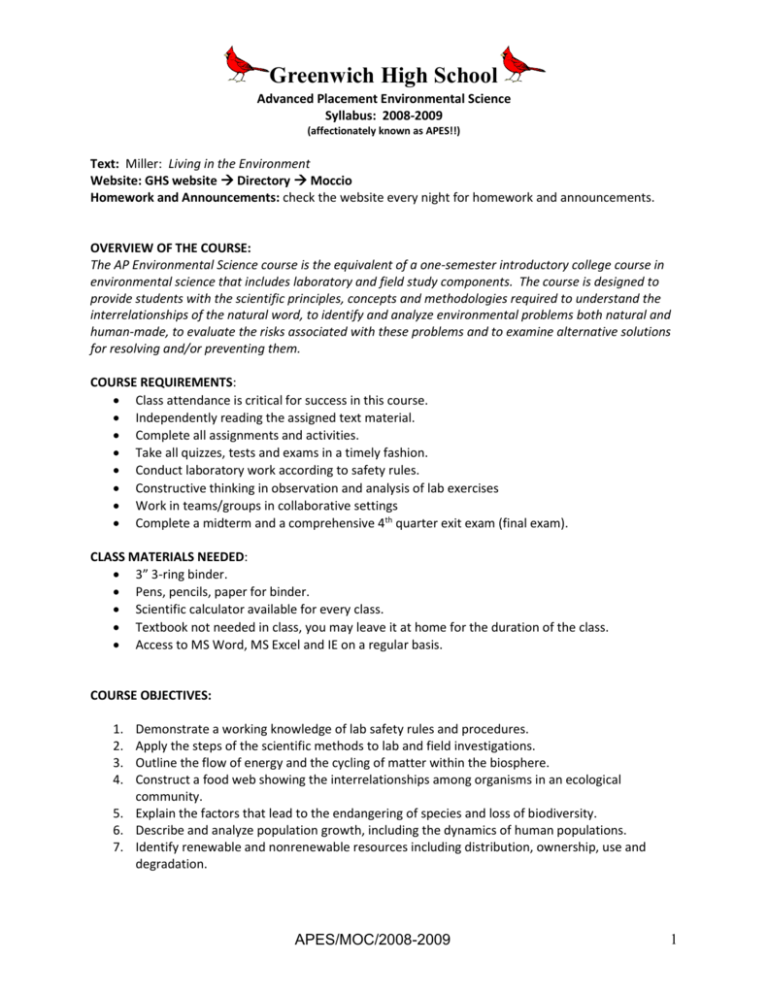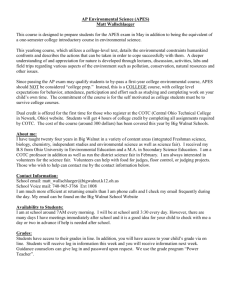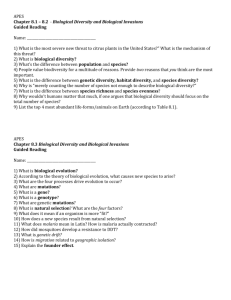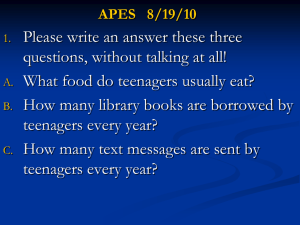Advanced Placement Environmental Science
advertisement

Greenwich High School Advanced Placement Environmental Science Syllabus: 2008-2009 (affectionately known as APES!!) Text: Miller: Living in the Environment Website: GHS website Directory Moccio Homework and Announcements: check the website every night for homework and announcements. OVERVIEW OF THE COURSE: The AP Environmental Science course is the equivalent of a one-semester introductory college course in environmental science that includes laboratory and field study components. The course is designed to provide students with the scientific principles, concepts and methodologies required to understand the interrelationships of the natural word, to identify and analyze environmental problems both natural and human-made, to evaluate the risks associated with these problems and to examine alternative solutions for resolving and/or preventing them. COURSE REQUIREMENTS: Class attendance is critical for success in this course. Independently reading the assigned text material. Complete all assignments and activities. Take all quizzes, tests and exams in a timely fashion. Conduct laboratory work according to safety rules. Constructive thinking in observation and analysis of lab exercises Work in teams/groups in collaborative settings Complete a midterm and a comprehensive 4th quarter exit exam (final exam). CLASS MATERIALS NEEDED: 3” 3-ring binder. Pens, pencils, paper for binder. Scientific calculator available for every class. Textbook not needed in class, you may leave it at home for the duration of the class. Access to MS Word, MS Excel and IE on a regular basis. COURSE OBJECTIVES: 1. 2. 3. 4. Demonstrate a working knowledge of lab safety rules and procedures. Apply the steps of the scientific methods to lab and field investigations. Outline the flow of energy and the cycling of matter within the biosphere. Construct a food web showing the interrelationships among organisms in an ecological community. 5. Explain the factors that lead to the endangering of species and loss of biodiversity. 6. Describe and analyze population growth, including the dynamics of human populations. 7. Identify renewable and nonrenewable resources including distribution, ownership, use and degradation. APES/MOC/2008-2009 1 Greenwich High School 8. Discuss the state of the atmosphere in terms of weather, climate, air pollution, ozone and greenhouse gases. 9. Analyze the environmental quality of soil, air and water. 10. Explain how usable energy is generated from fossil fuels and alternative sources and the tradeoffs associated with their use. 11. Outline the processes involved in waste and sewage treatment. 12. Identify the problems associated with the disposal of solid and toxic wastes. 13. Identify global changes and their consequences. 14. Describe the problems associated with agriculture and food production in today’s world. 15. Explain environmental problems in relationship to scientific, social, cultural and economic factors. 16. Relate course topics to local problems faced by Connecticut residents. 17. Demonstrate an awareness of careers related to environmental science. 18. Discuss the effects of environmental quality on human health. Grading Rationale Each quarter, grades will be calculated according to the following guidelines: 1. Tests will be averaged and this will comprise 60 % of the quarter grade. 2. Participation in Class Activities: will comprise 40% of the quarter grade. Categories of grades that will be included here are: a. labs b. projects c. current events reports d. quizzes e. collaboration in group activities f. attendance (including tardiness): excessive absences and tardiness will affect your final grade each quarter. 3. Exams: Midterm and Final exams are each 10% of the final grade for the year. 4. Due Dates: When class work is assigned with a due date, it will be date stamped when it is handed in. If you are absent (assuming it is excused), the work that is due is acceptable the next day without penalty. If it is one day late, the score is 75% of score, 2 days late 50% of score. Beyond that, no credit is given. 5. Test makeup due to absence: If you are absent for any test or quiz, it is YOUR RESPONSIBILITY to make up the test according to GHS policy (within 2 days for each day absent). You must make an appointment with me upon your return. Communication with me is YOUR responsibility. 6. WEBSITE: Every day, the website is updated to keep the class current. If you are absent it is a resource for you to be able to stay on top of what we are doing and to not fall behind. APES/MOC/2008-2009 2 Greenwich High School APES Outline 2008-2009 UNIT 1: Introductory Concepts: 3 weeks Ch. 1: Environmental Problems Ch. 2: Environmental History Ch. 3: Science, Systems and Energy Ch. 4: Energy Flow and Matter Cycling UNIT 2: The Biosphere: 8 weeks Ch. 5: Evolution Ch. 6: Terrestrial Biodiversity Ch. 7: Aquatic Biodiversity Ch. 8: Community Ecology Ch. 9: Population dynamics Ch. 12: Human Population Demographics UNIT 3: Sustaining Wildlife: 5 weeks Ch. 22: Sustaining Terrestrial Biodiversity Ch. 23: Ecosystem Approach Ch. 24: Sustaining Aquatic Biodiversity UNIT 4: The Lithosphere: Mineral and Energy Resources: 6 weeks Ch. 10: Soil Ch. 13: Food Ch. 15: Nonrenewable Energy Ch. 16: Efficiency and Renewable Energy UNIT 5: The Hydrosphere and Atmosphere: 7 weeks Ch. 14: Water Resources Ch. 19: Water Pollution Ch. 17: Air Pollution Ch. 18: Climate Change and Ozone Loss UNIT 6: Environment and Human Health: 3 weeks Ch. 11: Risk and Toxicology Ch. 20: Pesticides Ch. 21: Waste UNIT 7: Sustainability: 2 weeks APES/MOC/2008-2009 3







